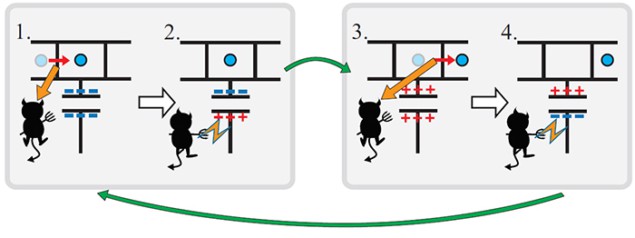
A “Maxwell’s demon” that operates without external control has been created by physicists in Finland. The device separates electrons in terms of their energies and prevents the higher-energy electrons from reaching a transistor – thereby cooling the transistor. The process occurs without the direct exchange of heat between the demon and the transistor and uses information about the energies of the electrons. While the demon does not violate any laws of thermodynamics, it highlights the role that information plays in thermodynamics and could have practical uses in cooling electronic circuits.
Maxwell first described his demon in 1867. He imagined a “finite being” that could operate a small door in a wall dividing a chamber into two halves. Initially, both halves are filled with a gas at a uniform temperature, which means that the molecules in the gas have velocities distributed about some average value. By opening and closing the door at just the right moments, the demon sorts the molecules so that faster-moving ones fill the left-hand side of the chamber, say, and slower ones the right. In the process, he transfers heat from a colder gas (the slower molecules) to a hotter one. If the door is frictionless, he appears to contravene the second law of thermodynamics.
Information about the position and velocity of each molecule is key to the demon’s success and the thought experiment has since been used to explore the role that information plays in thermodynamics. In 2010 Shoichi Toyabe of Chuo University in Tokyo and colleagues found that a micron-scale polystyrene particle immersed in a gas could be nudged slowly up an electrical “spiral staircase” – so gaining potential energy – as a result of random collisions with the gas molecules. This involved the researchers placing the electrical equivalent of barriers at just the right moments to prevent the particle from falling back down the stairs (see: “Information converted to energy“).
Outside action
This was the first time that scientists had quantified the extent to which information could be converted into energy; the particle’s ascent requiring no direct energy input but relying instead on information about its fluctuating position. That information, however, provided by a video camera and processed using image-analysis software, was analysed and acted upon from outside of the microscopic system. In other words, Maxwell’s demon was not acting autonomously.
In the latest work, Jonne Koski, Jukka Pekola, and colleagues at Aalto University in Finland have instead made a demon that acts without external control. The device consists of a single-electron transistor formed by connecting a micron-long copper island to two copper wires via tunnel junctions, which is linked to a tiny copper box. The box acts as the demon and initially contains a single electron generating a potential gradient across which an electron entering the transistor must climb (see figure). As soon as an electron reaches the island, the charge in the circuit changes, which causes the demon electron to tunnel out of its box. With the particles’ mutual repulsion lowered, the first electron becomes trapped on the island and then subsequently tunnels out of it.
Because only electrons with a certain minimum energy can reach the island, the most energetic electrons within a current flowing through the transistor will be siphoned off. The demon therefore cools the transistor, and thereby reduces its entropy, even though there is no direct heat exchange between it and the transistor. What has been exchanged instead, says Pekola, is information – via the electrons’ Coulomb interaction.
Demon watch
The researchers monitored their device by placing thermometers at the transistor’s input and output and also on a lead connected to the demon. As expected, they found that the transistor cooled down while the demon heated up. They also established that about four million electrons moved through the system every second. “In previous experiments, the demon consisted of macroscopic measurement devices, which meant there was no way to know about the energy flows within it,” says Pekola. “But here we can look at the thermodynamics of the demon itself.”
The device is described in Physical Review Letters and in an accompanying commentary, Sebastian Deffner of Los Alamos National Laboratory in the US says that the Finnish team has made the autonomous version of Maxwell’s demon “a physical reality”. The new device, he says, “fully agrees with our simple intuition – namely that information can be used to extract more work than seemingly permitted by the original formulations of the second law [of thermodynamics]”. He adds: “This doesn’t mean that the second law is breakable, but rather that physicists need to find a way to carefully formulate it to describe specific situations.”
Critical components
According to Pekola, the work does not have immediate practical applications, although he says that the information exchange between transistor and demon might in future allow heat to be channelled away from critical components within electronic circuits.
Pekola and colleagues are now turning their attention to the quantum regime, establishing how concepts such as heat and work change when electrons no longer “jump up and down hill”, as he puts it, but instead exist in quantum superpositions. To do this, they plan to use a chip containing superconducting rather than normal metal elements.



